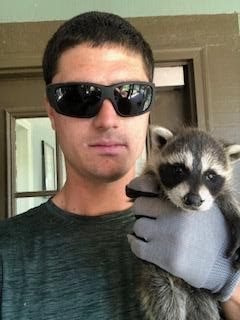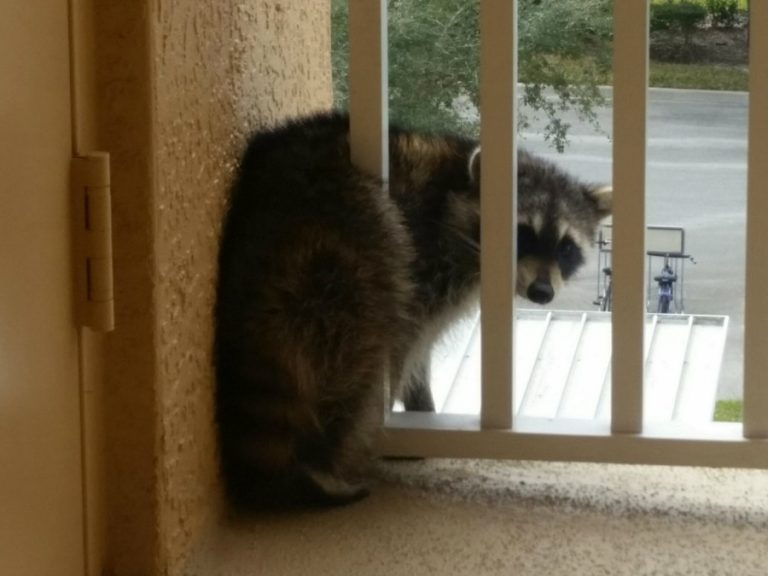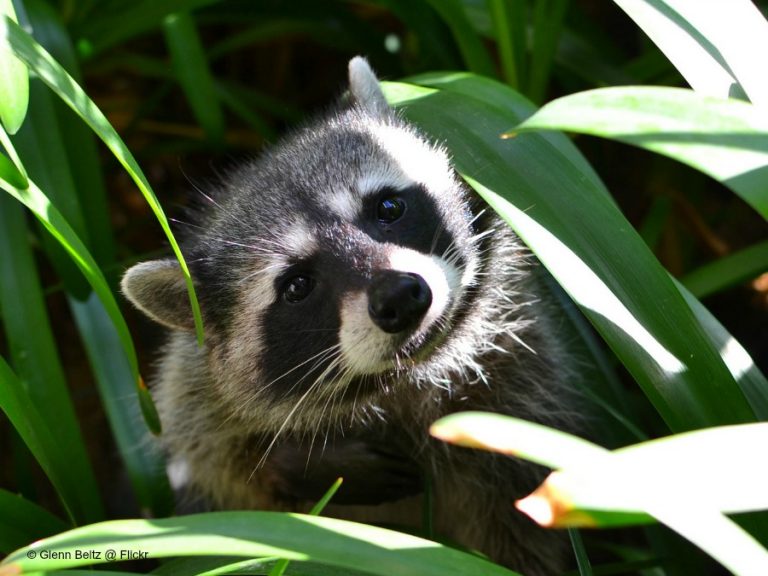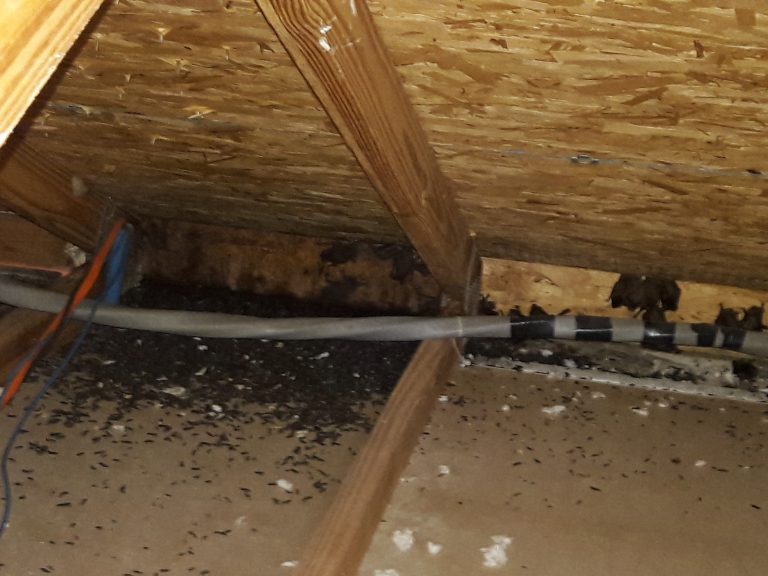
It is the middle of the night, you are sound asleep until a loud thud jolts you awake, you are not sure where the noise came from or what made the noise. Quietly listening, your suspicions are soon realized when the sound of claws comes from above your head, and you know that somewhere, there is a raccoon in the attic.
Many people experience this exact scenario in their own homes every week around Melbourne Florida, but many are unaware of just how common this is and how many people are affected each year with this, and ask any of them, it is no pleasant experience. Raccoons in the attic are a definite problem in and around the central Florida area, chances are is you live or even visit here, you know or have met someone who has had this problem. Thankfully there is an entire industry dedicated to help solve this ever increasing problem one house at a time.
It is important to understand first and foremost that when dealing with any type of wildlife, especially raccoons; it is always recommended to get licensed professionals to safely and humanely remove the animal rather than attempting to do it on your own. They are referred to as “wildlife” due to the fact that these are wild animals that can sick, diseased, aggressive, and are certainly unpredictable, especially when they feel threated which is certainly always the case.
Licensed professionals have the knowledge on how to conduct raccoon removal and have the proper tools to perform the task safely and humanely. Trust us, LEAVE THIS TO THE PROS.
Now that we have gotten that out of the way, the next thing to understand about Raccoons in the attic is how destructive they can be in a short time.

I take that back, any wildlife, not just raccoons in your attic can be very destructive quite quickly, this problem is nothing to mess around with; if you are hearing noises in your attic then you should call a wildlife removal company ASAP and have someone come and inspect whatever the issue might be. We are focusing in this blog however on raccoons in particular, and like we have explained, there are a variety of ways that raccoons can cause property damage to a home in no time at all. Some of these include damage to roofs, soffit and fascia, gutters, as well as all the damage that can be done inside the attic. They are known to commonly leave large amount of droppings in attics which can pose a serious health risk to anyone living in the house, this usually results in attic restorations to remove any bio hazardous waste that could be potentially dangerous. Needless to say, raccoons in your attic are a serious problem and need to be dealt with immediately.
There is lot to know when it comes to dealing with different kinds of wildlife and how to approach the unique situations that each of them can cause, but our desire is to educate the public on these common problems facing our communities. There are many ways an individual or homeowner can be proactive when it comes to wildlife, and over the next several sections, we hope to explore five signs that raccoons are in your attic in Melbourne Florida, and how you can easily determine if there is a problem or not. We hope this is educational and enlightening to anyone facing this problem or anyone wishing to learn something new.
I Hear Noises in my Attic
When looking into ways of determining if there are animals in the attic, the first and arguably the most obvious sign that something is alive in your attic or walls are the noises that will be made. Most wildlife such as raccoons that get into people’s homes are nocturnal, though there animals that sleep at night. Most in this particular industry are nocturnal, meaning they sleep during the day and become active throughout the night. This will usually result in a person hearing noises in the attic during the later hours of the night and the raccoons become active.

Every house makes noise in one way or another; wildlife noises however will be very distinguishable from common “house” noises. It is not too often that some creaking boards sound like claws or a tail dragging against drywall.
When these noises start to occur in someone’s homes, the first and most common issue that arises is being woken up from sleep throughout the night. Not every person are a heavy sleeper and usually at least one person in a home will be unable to sleep while something is crawling around in the attic. It is common for people to assume the animal will come and go and so they brush off the noises and give it a few days to see if the animal comes back. This is most definitely the wrong move, when there are noises in the attic, the best thing to do is to immediately call a wildlife removal company and get them out there. From our years of experience, we can tell you that if there is an animal in your attic, it is most likely setting up shop and has no intention of moving out unless you force them to. Let’s continue to explore some more easy ways to see if you might be dealing with raccoons.
Damaged Soffit and Roof
Let’s face it, a person’s home is there castle and everyone wants a good looking castle, including you. Even if you don’t own a home and you are renting, chances are you notice when something looks good and when something looks damaged or out of place, well if you are one of these people then you should have no problem easily crossing this off your wildlife checklist. We are going to take a look at the roof of your house and the soffit as well. You might ask why and the reason is that if a raccoon has gotten into your attic, then there is obviously some type of entry point on the exterior of the home unless of course they rang the doorbell and you let them in, unlikely.

Every house is slightly different but there is a fair amount of common ground between different styles of home, they definitely almost always have a roof and some type of soffit which allows the attic to ventilate excess heat and moisture. Now between the two, raccoons get into the attic most often through the soffit, but they are strong enough to rip through shingle and plywood when motivated enough. Soffit is a much weaker material and is manipulated much easier by the raccoons. The above picture shows an area of a shingle roof house where a raccoon has gained entry in through a piece of soffit that has been pushed up, creating an opening which in turn becomes their front door. If you go outside your house and see an area of your soffit that looks similar to this, we highly recommend calling a wildlife removal company ASAP because you are probably not far off from hearing noises in the attic. Sometimes if you own or live in a large house, some of these areas called roof returns will be impossible to see from the ground and will require someone going onto the roof for a closer inspection. Whenever this is the case we always recommend calling professionals to do the dangerous work rather than risking your own health and safety.
So far we have briefly explored two simple signs that you have raccoons in your attic, but there are still a few we want to cover in this blog post. In the next section we will take a look at some common signs that you have raccoons from inside the attic.
Urine and Droppings in the Attic

We have reiterated this many times throughout the blog, but we must start this section off again by addressing the need for upmost safety when concerning these issues. Urine and Raccoon droppings scattered throughout your attic is a very good sign that you might have raccoons in your attic, but BE CAREFUL, these can be very toxic to breathe in so when dealing with these issues, it is recommended to leave it to the professionals to properly inspect and solve the problem in a safe way for you. Raccoons are notorious for nesting in people’s homes, it is almost always a female raccoon that has babies or is preparing to have babies. They break in, create their nest, and get ready to settle in for the next months while their babies grow and become strong enough to leave on their own. During these months, it is common that over time the mother and babies will deposit a large amount of droppings and urine on top of the insulation that exists in the attic, this is turn can make it dangerous to go into the attic and can even create health hazards within the home.
When this occurs, what usually needs to happen is the raccoon removal must be performed to remove the raccoon safely, and then a team needs to go in a remove all soiled insulation and sanitize the attic space before it does not pose a health risk. The amount of insulation that needs to be removed will vary on how bad the problem was and how long it was going on for. A small amount of insulation may be all that’s needs and sometimes every square in must be removed; we will discuss attic restoration on some of our later blog posts. Summarizing though, any kind of animal dropping inside the attic is a tell-tale sign that there is an animal in the attic and it’s time to call a professional wildlife removal company.
It sounds like Baby Raccoons

So far we have looked at and explore several different tips on how a homeowner can be proactive and try and determine if they are dealing with a raccoon problem. We have talked about different things to look for on the outside of the house and also what we can look for on the inside of the attic to help us paint a picture of what is going on. We talked about some common noises that point to raccoons such as clawing and scratching noises as well as loud thuds but there are others that can point to the same conclusion.
Baby raccoon noises are another very simple way to know and understand that there is definitely something going on up in your attic that needs addressing. Like we have previously discussed, the reason raccoons go into the attics is primarily due to females having babies, and like a good mother would do, she daily takes care of her young but providing for them while doing the same for her. This means that there are times when mama has to leave the babies alone while she leave and scavenges, which can leave the babies confused and scared. When frightened or scared they doing what most mammals do, they cry and they whimper, usually in a very high pitch as they call out for their mother. If you hear any type of cry or whimper coming from the attic or soffit of your house, you almost certainly have baby raccoons in your attic and mama is somewhere close by. If this is the case, immediately call a professional and have them come out and complete and inspection.
Neighborhood Reports
We all understand that in today’s world, people don’t seem to be as personable or approachable as they used to be, even next door neighbors won’t know a thing about each other. With this last tip on signs that raccoons are in your attic, we challenge each and everyone one of you to break the mold and go have a conversation with people in and around your neighborhood, it’s a great way to socially network the old fashioned way, and it helps strengthen the community as a whole. We recommend doing this because you will be surprised at what you can learn from your neighbors, and if one of them is reporting raccoon problems, this is a sign that you probably also have a problem. When a mother raccoon is preparing to have babies, she will create several different nesting sites to make sure she has back up plans if things go badly at any one of her nesting sites. This commonly means that in neighborhoods where raccoons frequent, multiple homes with be broken into by raccoons on the same night, often it is the same female raccoon scouting out new potential nesting sites. For this reason we say to ask around to see if any of your neighbors are dealing with any issues and if they are, it gives you an opportunity to be proactive and possibly deal with the issue right away, and you might make a new friend in the process, that’s what we call a win win.
It has been our pleasure making this blog post for the public to read and be educated on some signs that raccoons are in your attic, we hope this has been truly educational and we look forward to putting out much more content on raccoons as well and all other wildlife we deal with in the great state of Florida, until next time.
